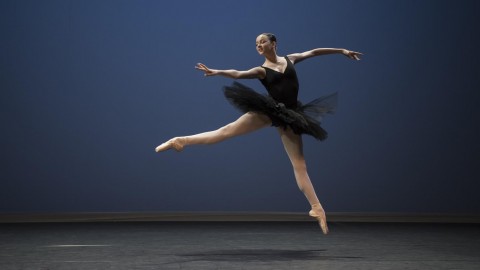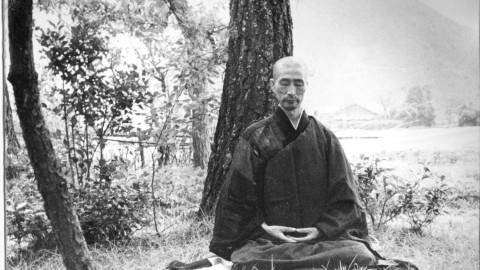I have heard about two Buddhist bhikkhus. One of them was a miser and a hoarder and he wanted to collect money and keep it, and the other used to laugh at this foolish attitude.
Whatsoever will come on his way, he will use it, he will never hoard it. One night they came across a river. It was evening, the sun was setting, and it was dangerous to stay there. They had to go to the other shore; there was a town. This side was simply wilderness.
The hoarder said, “Now you don’t have any money, so we cannot pay the ferryman. What do you say now about it? You are against hoarding; now if I don’t have any money we both will die. You see the point?” He said, “Money is needed.” The man who believed in renunciation laughed, but he didn’t say anything. Then the hoarder paid and they crossed the river; they reached the other shore. The hoarder again said, “Now remember, next time don’t start arguing with me. You see? Money helps. Without money we would have been dead. The whole night on the other shore, it was dangerous to survive – wild animals.”
The other bhikkhu laughed and he said, “But we have come across the river because you could renounce it. It is not because of hoarding that we have survived. If you had insisted on hoarding it and you were not going to pay the ferryman, we would have died. It is because you could renounce – because you could leave it, you could give it – that’s why we have survived.”
The argument must be continuing still. But remember, I am not against money. I am all for it, but use it. Possess it, own it; but your ownership arises only the moment you have become capable of giving it. At the throat center this new synthesis happens. You can accept and you can give.
There are people who change from one extreme to another. First they were incapable of giving, they could only receive; and then they change, they go to the other extreme – now they can give but they cannot receive. That too is lopsidedness. A real man is capable of accepting gifts and giving them. In India you will find many sannyasins, many so-called mahatmas, who will not touch money. If you give them any, they will shrink back, as if you have produced a snake or something poisonous. Their shrinking back shows that now they have moved to the other extreme: now they have become incapable of receiving.
Again their throat center is half-functioning – and a center never functions really unless it functions fully, unless the wheel moves the full way, goes on moving and creates energy fields.
Then is the third-eye center. At the third-eye center the right and left meet, pingala and ida meet, and become sushumna. The two hemispheres of the brain meet at the third eye; that is just between the two eyes. One eye represents the right, another eye represents the left, and it is just in the middle. These left and right brains meeting at the third eye, this is a very high synthesis. People have been capable of describing up to this point. That’s why Ramkrishna could describe up to the third eye. And when he started to talk about the final, the ultimate synthesis that happens at sahasrara, he again and again fell into silence, into samadhi. He was drowned in it; it was too much. It was floodlike; he was taken over to the ocean. He could not keep himself conscious, alert.
The ultimate synthesis happens at sahasrara, the crown chakra. Because of this sahasrara, all over the world kings, emperors, monarchs, and queens, use the crown. It has become formal, but basically it was accepted because unless your sahasrara is functioning, how can you be a monarch, how can you be a king? How can you rule people, you have not even become a ruler of yourself? In the symbol of the crown is hidden a secret. The secret is that a person who has reached to the crown center, the ultimate synthesis of his being, only he should be the king or the queen, nobody else. Only he is capable of ruling others, because he has come to rule himself. He has become a master of himself; now he can be helpful to others also.
Really, when you achieve sahasrara, A crown flower within you, a one-thousand petaled lotus opens. No crown can be compared with it, but then it became just A symbol.
And the symbol has existed all over the world. That simply shows that everywhere people became alert and aware in one way or another of the ultimate synthesis in the sahasrara. Jews use the skullcap; it is exactly on the sahasrara. Hindus allow a bunch of hair, they call it choti, the peak, to grow exactly on the spot where the sahasrara is or has to be. There are a few Christian societies which shave just that part of the head. When a Master blesses a disciple, he puts his hand on the sahasrara. And if the disciple is really receptive, surrendered, he will suddenly feel an upsurge of energy, running from the sex center to the sahasrara.
Osho says – Sometimes when I touch your head and you suddenly become sexual, don’t be afraid, don’t shrink back, because that is how it should be. The energy is at the sex center. It starts uncoiling itself. You become afraid, you shrink, you repress it – What is happening? And becoming sexual at the feet of your Master seems to be a little awkward, embarrassing. It is not. Allow it, let it be, and soon you will see it has passed the first center and the second and, if you are surrendered, within a second the energy is moving at the sahasrara and you will have a feeling of a new opening within you. That’s why a disciple is supposed to bow his head down, so the Master can touch the head.
The last synthesis is of object and subject, the outer and inner, again. In a sexual orgasm outer and inner meet, but momentarily. In sahasrara they meet permanently. That’s why I say one has to travel from sex to samadhi. In sex ninety-nine percent is sex, one percent is sahasrara; in sahasrar ninety-nine percent is sahasrar, one percent is sex. Both are joined; they are bridged by deep currents of energy. So if you have enjoyed sex, don’t make your abode there. Sex is just a glimpse of sahasrara. Sahasrara is going to deliver a thousandfold, a millionfold, a bliss to you, benediction to you.
The outer and the inner meet, I and thou meet, man and woman meet, yin and yang meet; and the meeting is absolute. Then there is no parting, then there is no divorce.
This is called yoga. Yoga means the meeting of the two into one. In Christianity mystics have called it UNIO MYSTICA; that is the exact translation of yoga. UNIO MYSTICA: the mysterious union. At the Sahasrara the alpha and the omega meet, the beginning and the end. The beginning is in the sex center, sex is your alpha; samadhi is your omega.
And unless alpha and omega meet, unless you have attained to this supreme union, you will remain miserable, because your destiny is that. You will remain unfulfilled. You can be fulfilled only at this highest peak of synthesis.
Now the sutras.
PERFORMING SAMYAMA ON THEIR POWER OF COGNITION, REAL NATURE, EGOISM, ALLPERVASIVENESS, AND FUNCTIONS BRINGS MASTERY OVER THE SENSE ORGANS.
The first thing to be understood is that you have senses but you have lost sensitivity.
Your senses are almost; dull, dead. They are there hanging with you, but energy is not flowing in them; they are not alive limbs of your being. Something has deadened within you, has become cold, blocked. It has happened to the whole of humanity because of thousands of years of repression. And thousands of years of conditioning and ideologies which are against the body have crippled you. You live only for name’s sake.
So the first thing to be done is: your senses should become really alive and sensitive.
Only then can they be mastered. You see but you don’t see deeply. You see only the surface of things. You touch but your touch has no warmth; nothing flows in and out from your touch. You hear it also. The birds go on singing and you hear and you can say, “Yes, I am hearing,” and you are not wrong – you are hearing – but it never reaches to the very core of your being. It does not go dancing within you; it doesn’t help a flowering, an unfolding within you.
These senses have to be rejuvenated. Yoga is not against the body, remember. Yoga says go beyond the body, but it is not against the body. Yoga says use the body, don’t be used by it; but it is not against the body. Yoga says the body is your temple. You are in the body, and the body is so beautiful an organism, so complex and so subtle, so mysterious, and so many dimensions open through it. And those senses are the only doors and windows through which you will reach God – so don’t deaden them. Make them more alive. Let them vibrate, pulsate, and, what Stanley Keleman has said, let them “stream.”
That is exactly the right word: let them flow like a stream, rushing. You can have the sensation. Your hand, if it is rushing like a stream of energy: you will feel a tingling sensation, you will feel something inside the hand is flowing and wants to make contact, wants to be connected.
When you love a woman or a man and you take her hand in your hand, if your hand is not streaming, this love is not going to be of any use. If your hand is not jumping and throbbing with energy and pouring energy into your woman or into your man, then this love is almost dead from the very beginning. Then this child is not born alive. Then sooner or later you will be finished – you are already finished. It will take a little time to recognize because your mind is also dull; otherwise you would not have entered into it, because it is already dead. For what are you entering? You take time to recognize things because your sensitivity, brilliance, intelligence, is so much clouded and confused.
Only a streaming love can become a source of blissfulness, of joy, of delight. But for that you will need senses streaming.
Sometimes you have that glimpse also; and everybody had it when he was a child. Watch a child running after a butterfly. He is streaming, as if any moment he can jump out of his body. Watch a child when he is looking at a rose flower. See his eyes, the brilliance, the light that comes to his eyes. He is streaming. His eyes are almost dancing on the petals of the flower.
This is the way to be: be riverlike. And only then is it possible to master these senses. In fact people have had a very wrong attitude. They think that if you want to master your senses you have to make them almost dead. But then what is the point of mastering? You can kill, and you are the master. You can sit on the corpse. But what is the point of being a master? But this looked easier: first to kill them, and then you can be master. If the body feels too strong, fast. Make it weak, and then you start feeling that you are the master.
But you have killed the body. Remember, life has to be mastered, not dead things. They will not be of any use.
But this has been found to be a shortcut, so all the religions of the world have been using it. Destroy your body by and by. Disconnect yourself from the body. Don’t be in contact.
Remove yourself away. Become indifferent. When your body is almost a dead tree; no longer do leaves come to it, no longer does it flower, no longer do birds come to rest. It is just a dead stump. Of course you can master it, but now what are you going to gain from this mastery?
This is the problem; that’s why people don’t understand what Patanjali means.
“Performing samyama on their power of cognition….” Your eyes see, your ears hear, your nose smells, your tongue tastes, your hands make contact, your feet make connectedness with the earth – that is their power of cognition.
“Performing samyama on, their power of cognition….” But they have to be powerful.
Otherwise you will not be able to even feel what power is. These senses have to be so full of power, so high with power, that you can perform samyama, that you can meditate upon them.
Tags: Patanjali Yoga Sutra 42 Power Of Cognition










